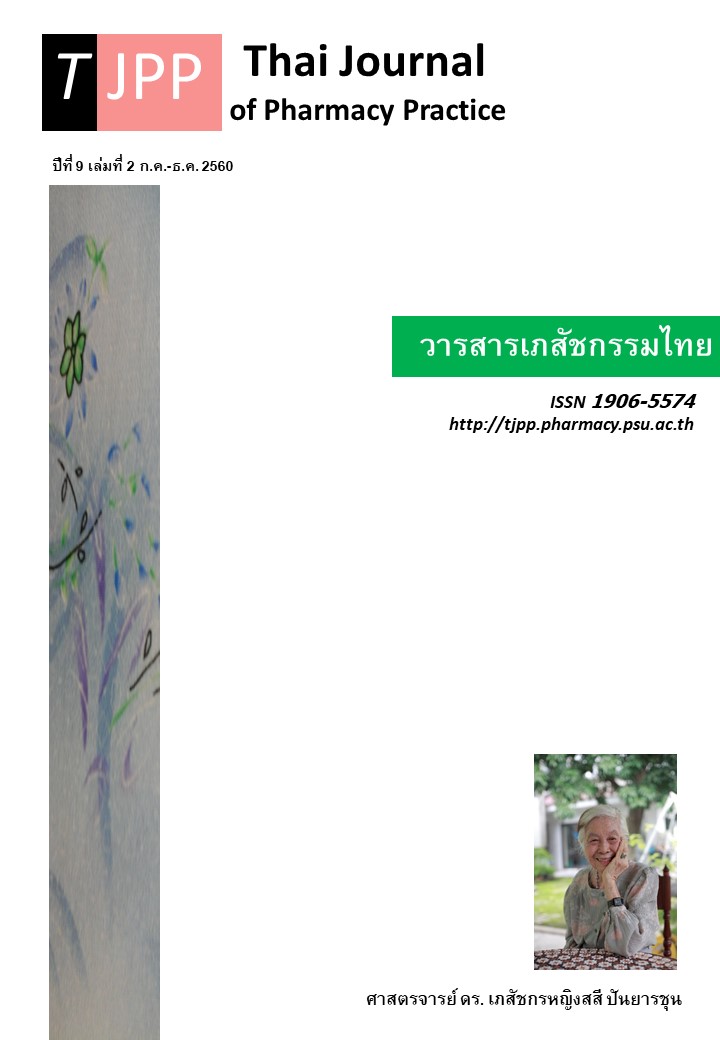ผลของการใช้ฉลากภาพที่บ่งบอกวิธีใช้ยาเม็ดชนิดรับประทานในผู้ป่วยชาวไทยมุสลิมที่ไม่รู้หนังสือ
Main Article Content
บทคัดย่อ
วัตถุประสงค์: เพื่อทดสอบความเข้าใจต่อฉลากภาพที่บ่งบอกวิธีใช้ยาเม็ดชนิดรับประทานในผู้ป่วยชาวไทยมุสลิมที่ไม่รู้หนังสือ และศึกษาผลของการใช้ฉลากภาพต่อความร่วมมือในการใช้ยา การจดจำวิธีใช้ยา และความพึงพอใจต่อฉลากยาของผู้ป่วยกลุ่มดังกล่าว วิธีการ: การวิจัยแบ่งเป็น 2 การศึกษา การศึกษาแรกเป็นการทดสอบความเข้าใจฉลากภาพในผู้ป่วยชาวไทยมุสลิมที่ไม่รู้หนังสือ 126 คน ฉลากภาพที่ทดสอบเป็นฉลากที่บ่งบอกวิธีใช้ยาเม็ดชนิดรับประทาน 10 วิธีที่พบบ่อยในโรงพยาบาลสุไหงปาดี ฉลากภาพที่ใช้เป็นฉลากที่พัฒนาโดยบวรรัตน์ อังศุวัฒนากุล และสงวน ลือเกียรติบัณฑิต ผู้วิจัยแสดงฉลากภาพ 4 ฉลากที่เลือกมาอย่างสุ่มแก่ตัวอย่างแต่ละราย จากนั้นสัมภาษณ์ตัวอย่างถึงความหมายของแต่ละภาพ ในการศึกษาส่วนที่สอง ตัวอย่าง คือ ผู้ป่วยชาวไทยมุสลิมที่ไม่รู้หนังสือและได้รับยารายการใหม่ ซึ่งถูกสุ่มแยกเป็นกลุ่มควบคุม 61 คนซึ่งได้รับฉลากยาข้อความ และกลุ่มทดลอง 61 คนที่ได้รับฉลากภาพเพิ่มเติมจากฉลากข้อความ ผลลัพธ์ที่ประเมินเมื่อผู้ป่วยกลับมาพบแพทย์อีกครั้งได้แก่ ความร่วมมือในการใช้ยา การจดจำวิธีใช้ยา และความพึงพอใจต่อฉลากยา การประเมินความร่วมมือในการใช้ยาทำโดยการนับเม็ดยาที่เหลือ การประเมินการจดจำวิธีใช้ยาและความพึงพอใจต่อฉลากยาใช้การสัมภาษณ์ ผลการวิจัย: ในการศึกษาส่วนแรก ตัวอย่างมากกว่าร้อยละ 93.9 เข้าใจความหมายของฉลากภาพถูกต้องครบทุกประเด็นทั้งจำนวนเม็ดต่อมื้อ ความถี่ในการรับประทานยา เวลาที่รับประทานยา และเวลาที่ใช้ยาเมื่อเทียบกับมื้ออาหาร (ก่อนหรือหลังอาหาร) ซึ่งผ่านเกณฑ์มาตรฐานของ American National Standard Institute (ANSI) ผลการศึกษาในส่วนที่สอง พบว่า กลุ่มทดลองมีความร่วมมือในการใช้ยา การจดจำวิธีการใช้ยา และพึงพอใจต่อฉลากยามากกว่ากลุ่มควบคุมอย่างมีนัยสำคัญทางสถิติ สรุป: สถานพยาบาลต่าง ๆ สามารถนำฉลากภาพที่พัฒนาโดยบวรรัตน์ อังศุวัฒนากุล และสงวน ลือเกียรติบัณฑิต ไปใช้ในผู้ป่วยชาวไทยมุสลิมที่ไม่รู้หนังสือ ฉลากภาพดังกล่าวสามารถเข้าใจได้โดยผู้ป่วยกลุ่มนี้ และสามารถเพิ่มความร่วมมือในการใช้ยา การจดจำวิธีการใช้ยา และความพึงพอใจของผู้ป่วยต่อฉลากยาได้
Article Details
ผลการวิจัยและความคิดเห็นที่ปรากฏในบทความถือเป็นความคิดเห็นและอยู่ในความรับผิดชอบของผู้นิพนธ์ มิใช่ความเห็นหรือความรับผิดชอบของกองบรรณาธิการ หรือคณะเภสัชศาสตร์ มหาวิทยาลัยสงขลานครินทร์ ทั้งนี้ไม่รวมความผิดพลาดอันเกิดจากการพิมพ์ บทความที่ได้รับการเผยแพร่โดยวารสารเภสัชกรรมไทยถือเป็นสิทธิ์ของวารสารฯ
เอกสารอ้างอิง
2. National Statistics Office. Summary of main results from the survey of reading skill of the population in 2015 [online]. 2015 [cited Dec 8, 2016]. Available from: service.nso.go.th/nso/nsopublish/themes/files /readingPocket58.pdf
3. Ngoh LN, Shephred MD. Design, development, and evaluation of visual aids for communicating prescription drug instructions to non-illiterate patients in rural Cameroon. Patient Educ Couns 1997; 30: 245-61.
4. Houts PS, Doak, CC, Doak LG, Loscalzo MJ. The role of pictures in improving health communication: a review of research on attention, comprehension, recall, and adherence. Patient Educ Couns 2006; 61: 173-90
5. Katz MG, Kripalani S, Weiss BD. Use of pictorial aid
s in medication instructions: a review of the literature. Am J Health-Syst Pharm 2006; 63: 2391 -7.
6. Mansoor LE, Dowse R. Effective of pictograms on r
eadability of patient information materials. Ann Pharmacother 2003; 37: 1003-9.
7. Mansoor LE, Dowse R. Design and evaluation of a new pharmaceutical pictogram sequence to convey medicine usage. Journal of the Ergonomics Society of South Africa 2004; 2:29-41.
8. United States Pharmacopeial Convention. USP pictograms [online]. 2011 [cited Dec 6, 2015]. Available from: www.usp.org/usp-healthcare-profes sionals/related-topicsresources/usp-pictograms/ download-pictogram
9. Dowse R, Ehlers MS. The evaluation of pharmaceutical pictograms in a low-literate South African population. Patient Educ Couns 2001; 45: 87-99
10. Noiprom S, Srichatchawan S. Understanding of the USP DI pictograms among outpatients at Her Royal Highness Princess Maha Chakri Sirindhorn Medical Center, Nakhon Nayok Province. Thai Pharmaceutical and Health Science Journal 2005; 1: 270-1
11. Doak CC, Doak LG, Root JH. Teaching patients with low literacy skills. Philadelphia: J.B. Lippincott company; 1985.
12. Chaijinda K. Development and evaluation of pictorial labeling system for Northern Thai patients with low literate skills [dissertation]. Chiang Mai: Chiang Mai University; 2007.
13. Muangcharoen A. Development and evaluation of pharmaceutical pictograms in the Pga K'nyau, Sop Moei District, Mae Hong Son Province. [master thesis]. Chiang Mai: Chiang Mai University; 2008.
14. Phimarn W, Pianchana P, Rungsungnoen R, Ritthiya L, Pattaradunpituk W. Development and evaluation of pictorial labeling system for elderly patients with chronic disease. Isan Journal of Pharmaceutical Sciences 2014; 9(Supplement): 109-15.
15. Angsuwattanakul B, Lerkiatbundit S. Development of pictograms for illiterate patients part 1: instructions on how to take tablets. Thai Journal of Pharmacy Practice 2014; 6: 41-60.
16. American National Standard Institute. Accredited standard on safety colours, signs, symbols, labels, and tags, vol. Z535. Washington (DC): National Electrical Manufacturers Association, 1991.
17. Cochran WG. Sampling techniques. 3rd ed. New York: John Wiley & Sons; 1977
18. Bullinger M, Alonso J, Apolone G, Leplège A, Sullivan M, Wood-Dauphinee S, et al. Translating health status questionnaires and evaluating their quality: the IQOLA Project approach. J Clin Epidemiol 1998; 51: 913-23.
19. Faul F, Erdfelder E, Lang AG, Buchner A. G*Power 3: A flexible statistical power analysis for the social, behavioral, and biomedical sciences. Behav Res Methods. 2007; 39: 175-91.
20. Yadav S, Khatri S, Gehlaut R, Mishra N, Mittal P. Pharmaceutical pictogram in rationale use of drug and development of pharmaceutical care services: A mini review. International Journal of Research in Pharmaceutical and Biomedical Sciences. 2012; 3: 215-21.
21. Yin HS, Dreyer BP, Schaick LV, Foltin GL, Dinglas C, Mendelsohn AL. Randomized controlled trial of a pictogram-based intervention to reduce liquid medication dosing errors and improve adherence among caregivers of young children. Arch Pediatr Adolesc Med 2008; 162: 814-22.


